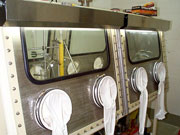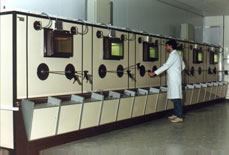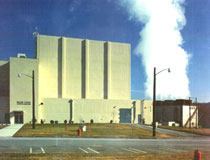Overview
DOE Isotope Facilities
NEPRI
ANMI
FAQs
Isotope Uses
Science Glossary
Catalog of Isotopes
Publications and
Fact Sheets
Ask Us A Question
DOE has at its disposal unique facilities: the national laboratories. Here, reactors and accelerators capable of reaching energies generally well beyond commercial capabilities are used to produce radioisotopes beneficial to many people, programs, and plans.
Click on an item in the list below to go directly to that section.
- Reactors
- Accelerators
- Future Accelerator Production Capabilities
- Hot Cells
- Stable Isotope Enrichment Unit
- Materials and Chemical Laboratories
- By-products
- Stable Isotopes in Inventory
Reactors
Radioisotopes are produced in several ways. Some isotopes require a source of neutrons in order to produce them. (Neutrons are subatomic particles that have no electric charge and therefore can not be accelerated using electric and magnetic fields.) These isotopes are made in reactors where a high flux of neutrons is used to irradiate specially made target materials that capture these neutrons and thereby make the isotopes of interest. A high flux
Products made at this facility include nickel-63, tungsten-188, rhenium-186, californium-252, and iridium-192, among others. Tungsten-188 is used as a generator of rhenium-188, which is used to prevent restenosis in patients recovering from heart surgery and to relieve bone pain. Californium-252 is used as a reactor startup fuel and to detect land mines. Iridium-192 is widely used in radiography.

A second reactor, the Advanced Test Reactor (ATR) at the Idaho National Engineering and Environmental Laboratory (INEEL), also regularly produces radioisotopes. The 250-megawatt ATR has
Accelerators
Other radioisotopes require a source of energetic protons to drive the nuclear reactions responsible for their production. These isotopes are produced in accelerators where the subatomic, positively charged protons are sped up (accelerated) and then used to bombard targets in order to produce the required isotopes. As with neutrons, a high flux of protons is required.
The large linear accelerators at Los Alamos National Laboratory (LANL) and Brookhaven National Laboratory (BNL) supplement the well-developed production of isotopes in low-energy cyclotrons distributed throughout the United States by producing heavier isotopes that cannot be produced in the smaller machines.
The Los Alamos Neutron Science Center (LANSCE) at LANL is a The site's three major products include germanium-68, a calibration source for positron emission tomography (PET) scanners;
strontium-82, the parent of rubidium-82 that is used in cardiac PET imaging; and sodium-22, a The Brookhaven Linac Isotope Producer (BLIP) at BNL utilizes the excess beam of a linear accelerator that injects 200 million electron volt protons into the 33 giga electron-Volt. Alternating Gradient Synchrotron. The BLIP facility produces such radioisotopes as strontium-82, germanium-68, technetium-95m, and copper-67, used for medical and therapeutic purposes, and others such as beryllium-7.
Future Accelerator Production Capabilities
When completed, the Isotope Production Facility (IPF) at LANL will produce radioisotopes almost year round by using a fraction of the LANSCE primary proton beam (see above). The main systems of IPF will include a new beam line that extends to the below-ground target irradiation area, upper and lower level buildings that will house special equipment, and a hot cell in the upper level of the facility to handle the irradiated targets. Many of the isotopes scheduled for production at IPF will provide for the future advancement of nuclear medicine applications and the continuation of human clinical studies.
Furthermore, a conceptual design has been developed for a 70 MeV cyclotron to be built at BNL for dedicated isotope production. Together with IPF, this accelerator should supply the projected yearly need for short-lived, accelerator-produced isotopes for the next 20 years.
Hot Cell Facilities
Isotope Programs makes use of hot cell facilities at Oak Ridge National Laboratory (ORNL), INEEL, LANL, and BNL. A hot cell is a closed work area in which radioactive materials may be manipulated without exposing the operator to gamma radiation. Some cells are dedicated to the production of a single radioisotope in order to minimize contamination. Other cells are used to process a wide range of isotopes while still others are used for storage and transfer functions. They are an integral part of radioactive isotope production and their care and maintenance are high priorities.
In fiscal year (FY) 2003, DOE will undertake a major renovation of the Bethel Valley Hot Cell Complex at ORNL. Originally constructed in the early 1940's to support nuclear research and development missions, this complex is comprised of six nuclear facilities. These facilities were initially designed with unique capabilities to support specific program requirements and were funded by mission sponsors. Currently, scientists and technicians are actively engaged in nuclear energy research and isotope processing. Various upgrades will improve the safety and reliability of nuclear and radiological operations and improve worker safety. Related support facilities that are centrally located at the main ORNL campus are also included in this renovation project.
Stable Isotope Enrichment Unit
Experience has shown there are two specific areas where Isotope Programs must be positioned to fulfill a national need: (1) small (milligram) quantities of isotopes for researchers and (2) medium (gram) quantities of isotopes for commercial customers that are not available from other sources.
To fulfill this national need and to meet future stable isotope demands, DOE plans to purchase a small, commercially available electromagnetic isotope separator. Studies indicate that a combination of a new, smaller (than existing) electromagnetic separator and the use of a plasma separator being tested by the University of California at Los Angeles (UCLA) will be best suited to meet projected needs for DOE isotopes not supplied by the private sector.
DOE plans to eliminate obsolete capability and replace it with more efficient production capability to better serve researchers and provide stable isotopes at affordable prices.



 The
The